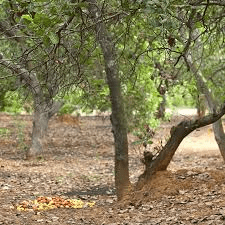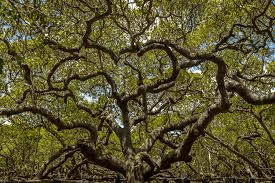Cashew branches are the woody structures that extend from the main trunk of the cashew tree (Anacardium occidentale) and bear leaves, flowers, and fruit. These branches play a crucial role in the growth, development, and productivity of the cashew tree.
The branches of the cashew tree vary in size, shape, and orientation depending on factors such as genetics, age, and environmental conditions. Young cashew trees typically have flexible, slender branches that grow vigorously as the tree matures. As the tree ages, the branches become thicker and more rigid, providing structural support for the canopy of leaves and fruit.
One important function of cashew branches is to support the growth of leaves, which are essential for photosynthesis, the process by which plants convert sunlight into energy. The leaves on cashew branches are broad, glossy, and elliptical in shape, providing a large surface area for capturing sunlight and absorbing carbon dioxide from the air.
Cashew branches also bear the reproductive structures of the tree, including flowers and fruit. The flowers of the cashew tree develop on short stalks called pedicels, which emerge from the axils of the leaves along the branches. These flowers give rise to cashew nuts, which develop from the ovary of the flower after fertilization.
In addition to their role in reproduction, cashew branches provide habitat and food for various organisms, including insects, birds, and small mammals. Insects may feed on the leaves, flowers, or sap of the branches, while birds may perch on the branches or build nests among the foliage.
Cashew branches are also important in traditional agriculture and agroforestry systems, where they may be pruned or coppiced to promote branching and increase yield. Pruning can also help maintain the overall health and productivity of the tree by removing dead or diseased branches and promoting the growth of new shoots.
Furthermore, cashew branches have practical applications in industries such as woodworking and fuel production. The wood of the cashew tree is hard and durable, making it suitable for construction, furniture-making, and other woodworking applications. Branches and prunings may also be used as a source of biomass for fuel or charcoal production.
Overall, cashew branches are essential components of the cashew tree, supporting the growth, reproduction, and ecological interactions of the tree within its habitat. Their diverse functions and practical applications make them valuable resources with significance in both natural ecosystems and human societies.
The Economic Importance and Uses of Cashew Branches

1. Shade Provision: Cashew branches provide shade for crops, livestock, and humans, helping to mitigate heat stress and create microclimates conducive to plant growth.
2. Livestock Fodder: Cashew branches are utilized as fodder for livestock, providing a source of nutrition and contributing to animal health and productivity.
3. Fuelwood: Cashew branches serve as a source of fuelwood in many regions, providing energy for cooking, heating, and industrial processes.
4. Agroforestry: Cashew trees, including their branches, play a vital role in agroforestry systems, providing shade, windbreaks, and soil stabilization in agricultural landscapes.
5. Soil Erosion Control: Cashew branches help prevent soil erosion by providing vegetative cover and reducing water runoff, making them valuable in erosion-prone areas.
6. Traditional Crafts: Cashew branches are used in traditional crafts and artisanal products, such as basket weaving and woodcarving, showcasing their natural beauty and versatility.
7. Biomass Production: Cashew branches can be harvested for biomass production, providing a renewable source of energy for cooking, heating, and electricity generation.
8. Landscape Decoration: Cashew branches are utilized in landscaping projects for their aesthetic appeal, adding texture and visual interest to gardens, parks, and urban spaces.
9. Agroecological Practices: Cashew branches contribute to agroecological practices such as intercropping and alley cropping, promoting biodiversity and sustainable land management.
10. Soil Improvement: Cashew branches, when decomposed, enrich the soil with organic matter and nutrients, improving soil fertility and structure for plant growth.
11. Traditional Medicine: Extracts from cashew branches are used in traditional medicine for their potential medicinal properties, including treating fever, diarrhea, and inflammation.
12. Carbon Sequestration: Cashew branches contribute to carbon sequestration efforts by absorbing and storing carbon dioxide from the atmosphere, mitigating climate change impacts.
13. Horticultural Support: Cashew branches provide support for climbing crops such as beans and vines, enhancing crop productivity and yield in mixed cropping systems.
14. Environmental Conservation: Cashew branches support environmental conservation efforts by providing habitat and food for wildlife in cashew orchards and surrounding ecosystems.
15. Artisanal Crafts: Cashew branches are used in artisanal crafts and artwork, such as sculptures and decorative items, reflecting cultural heritage and creativity.
16. Landscaping: Cashew branches are utilized in landscaping projects for their structural qualities, providing architectural interest and defining outdoor spaces.
17. Economic Opportunities: Cashew branch collection and processing provide economic opportunities for communities in cashew-growing regions, contributing to rural livelihoods and economies.
Read Also: All You Need to Know About Eggs
The Products and By-products That Can Be Derived From Cashew Branches

1. Livestock Feed: Cashew branches are utilized as fodder for livestock, providing a source of nutrition and contributing to animal health and productivity.
2. Fuelwood: Cashew branches serve as a source of fuelwood in many regions, providing energy for cooking, heating, and industrial processes.
3. Handicrafts: Cashew branches are used in traditional crafts and artisanal products, such as basket weaving and woodcarving, showcasing their natural beauty and versatility.
4. Biomass Fuel: Cashew branches can be harvested for biomass production, providing a renewable source of energy for cooking, heating, and electricity generation.
5. Soil Erosion Control: Cashew branches help prevent soil erosion by providing vegetative cover and reducing water runoff, making them valuable in erosion-prone areas.
6. Mulch: Chipped or shredded cashew branches are used as mulch in gardening and agriculture, conserving moisture, suppressing weeds, and improving soil health.
7. Compost Material: Cashew branches, when decomposed, enrich the soil with organic matter and nutrients, improving soil fertility and structure for plant growth.
8. Traditional Medicine: Extracts from cashew branches are used in traditional medicine for their potential medicinal properties, including treating fever, diarrhea, and inflammation.
9. Carbon Sequestration: Cashew branches contribute to carbon sequestration efforts by absorbing and storing carbon dioxide from the atmosphere, mitigating climate change impacts.
10. Horticultural Support: Cashew branches provide support for climbing crops such as beans and vines, enhancing crop productivity and yield in mixed cropping systems.
11. Environmental Conservation: Cashew branches support environmental conservation efforts by providing habitat and food for wildlife in cashew orchards and surrounding ecosystems.
12. Landscape Decoration: Cashew branches are utilized in landscaping projects for their aesthetic appeal, adding texture and visual interest to gardens, parks, and urban spaces.
13. Livelihood Support: Cashew branch collection and processing provide economic opportunities for communities in cashew-growing regions, contributing to rural livelihoods and economies.
14. Agroecological Practices: Cashew branches contribute to agroecological practices such as intercropping and alley cropping, promoting biodiversity and sustainable land management.
15. Shade Provision: Cashew branches provide shade for crops, livestock, and humans, helping to mitigate heat stress and create microclimates conducive to plant growth.
16. Economic Opportunities: Cashew branch collection and processing provide economic opportunities for communities in cashew-growing regions, contributing to rural livelihoods and economies.
17. Timber Substitute: In some regions, cashew branches are used as a substitute for timber in construction and woodworking projects, particularly in rural communities.
Read Also: Is Backyard Beekeeping Safe?
Frequently Asked Questions (FAQ’s) About Cashew Branches
1. What are cashew branches used for?
Cashew branches have various uses, including providing shade, serving as livestock fodder, and contributing to biomass production for fuelwood and energy generation.
2. Can cashew branches be used as fuelwood?
Yes, cashew branches are commonly used as a source of fuelwood for cooking, heating, and industrial processes in regions where alternative fuel sources may be scarce.
3. Are there any environmental benefits to using cashew branches?
Yes, cashew branches support environmental conservation efforts by providing habitat and food for wildlife, preventing soil erosion, and sequestering carbon dioxide from the atmosphere.
4. How are cashew branches harvested?
Cashew branches are typically pruned or harvested from cashew trees using sharp tools such as machetes or saws, taking care not to damage the tree itself.
5. Are cashew branches used in traditional medicine?
Yes, extracts from cashew branches are used in traditional medicine for their potential medicinal properties, including treating fever, diarrhea, and inflammation.
6. Can cashew branches be used as mulch?
Yes, chipped or shredded cashew branches are used as mulch in gardening and agriculture, conserving moisture, suppressing weeds, and improving soil health.
7. Do cashew branches provide shade?
Yes, cashew branches provide shade for crops, livestock, and humans, helping to mitigate heat stress and create microclimates conducive to plant growth.
8. Are there any economic opportunities associated with cashew branches?
Yes, cashew branch collection and processing provide economic opportunities for communities in cashew-growing regions, contributing to rural livelihoods and economies.
9. How do cashew branches contribute to soil improvement?
Cashew branches, when decomposed, enrich the soil with organic matter and nutrients, improving soil fertility and structure for plant growth.
10. Can cashew branches be used in landscaping?
Yes, cashew branches are utilized in landscaping projects for their aesthetic appeal, adding texture and visual interest to gardens, parks, and urban spaces.
Read Also: Potato Farming Guide – 7 Tips to Grow Sacks Full of Potatoes






